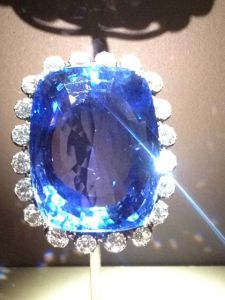The birthstone for April, from our historical listing beginning around 1,500 years ago, consistently gives us the sapphire, not the diamond. It isn’t until the 15th century that we begin to see the diamond listed along with the sapphire. Birthstones from ancient cultures, according to George Frederick Kunz, listed diamonds by Poles and Hindus, while Hebrews, Romans, and Russians listed the sapphire. Ancient Tibetans listed the blue opal.
The information given by Thelma Isaacs about the 12 stones in Aaron’s Breastplate, also indicates that the diamond wasn’t alwaysalways considered to be one of the 12 stones, which makes this esoteric and romanticized lore about the influence of gemstones all the more appealing.
Foundation Stones in the Revelation: Jasper, Sapphire, Chalcedony, Emerald, Sardonyx, Sardius, Chrysolite, Beryl, Topaz, Chrysoprase, Jacinth, Amethyst.
King James Bible: Sardius, Topaz, Carbuncle, Emerald, Sapphire, Diamond, Ligure, Agate, Amethyst, Beryl, Onyx, Jasper.
Correction to the Bible: Carnelian, Chrysolite, Emerald, Ruby, Lapis Lazuli, Onyx, Sapphire, Agate, Amethyst, Topaz, Beryl, Jasper.
George Kunz (1913): Red Jasper, Light Green Serpentine, Green Feldspar (Microcline)
Richardson/Huett (1980): Sard, Agate, Chrysolite, Garnet, Amethyst, Jasper, Onyx, Beryl, Emerald, Topaz, Sapphire, Diamond.
For the April native, the distinction of having the diamond as birthstone nowadays is quite special. Diamonds seem to gather all the qualities we ascribe to gemstones, such as color and sparkle, as well as mystery and social significance. Of course, with diamonds being one of the most common elements on earth and at the same time, the center of global economic conflict where human beings are cruelly exploited, it is impossible to think about them only as objects of beauty. For this reason, I will add relevant sources at the end of this post so we can be well informed.
Isaacs writes, “Small diamonds, formed by the heat and pressure of impact, have been found in some meteorites.” (49) This fact alone is fascinating. Can we think of gemstones existing in other worlds beyond Earth? Beyond our own universe? Why not! We really are made of stars.
In crystallography, the form of the diamond is commonly octahedral, dodecahedral, cubic or tetrahedral. The hardness in the Moh’s Scale is 10, making it the hardest natural substance. The composition of diamond is Carbon, and curiously the other form of carbon, graphite, is one of the softest minerals.
Diamond, whose name derives from the Greek adamas, means ‘unconquerable,” and in a sense lends the gemstone the perception of a warlike character trait. To extend this supposition a bit further, consider that the constellation of Aries, the Zodiac sign most often associated with the month of April, comes from the Greek Ares, or War. It also brings to mind the element of fire, and we know that Aries is a fire sign!
Since ancient times, people have ascribed special properties to gemstones and used them in healing as well as in ritual practices and magic. I choose to see them as beautiful minerals to be enjoyed, as an aid in meditation, relaxation, and as artistic inspiration. I also think that there is something to be said for the pleasure of identifying yourself with a beautiful stone, and to be able to wear it with joy. Most gemstones today are mined in harsh conditions that are dangerous for the people who toil in them. The greater benefit goes to the companies who process and sell gems in the world market. How can we, then, even think about participating in this questionable enterprise?
One way, is by educating ourselves about the provenance of the jewels we wear, and by not contributing to the over-production of new stones. It is possible to look for ‘non-conflict’ stones, for stones that are beautiful but not expensive, and by making a commitment to repurposing and recycling old jewelry. If we place value in craft and artistry, we can help to turn the tide of consumerism. Our creativity comes from within, from our life energy, and we can nourish it in turn to enjoy life.
My favorite images of stones in view today, are the ones provided by the Smithsonian, since they are not only fabulous, but tend not to be connected with a particular commercial jeweler. Except for the Hope Diamond (which is exhibited in its new setting by Harry Winston). But despite the fact that most of us associated diamonds as peerless transparent stones with dazzling brilliance, the lovely colors of diamonds will most likely spark the imagination for generations to come. Here is the Hope in the older, traditional setting:
Books about the history of diamonds, mining, and commerce–
-Bergner, Daniel. In the Land of Magic Soldiers
-Campbell, Greg. Blood Diamonds: Tracing the Deadly Path of the World’s Most Precious Stones
-Roberts, Janine P. Glitter & Greed


Thank you for the informative post on diamonds!Very nice.
What a very good article and definitely served to clear my
brain a little bit
Great to hear- diamonds will do that to you! 😉